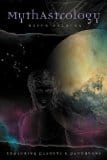
MythAstrology: Exploring Planets & Pantheons
, by Raven Kaldera
Llewellyn, 0738705160, 436 pp. (incl. appendix), 2004
It has been a while since I read an astrology book that struck me as unique and useful, and MythAstrology fits both those criteria. When learning, teaching or discussing astrology sometimes it is all too easy to rely on cookie cutter phrases, that you may not truly understand, sometimes they even become crutches that prevent deeper understanding. Kaldera introduces an other way to understand and view the different placements in the chart, by associating the placement of each planet in every sign with a God and some of their mythology.
Even as someone who has seriously studied astrology, I found this book useful, insightful and hilariously accurate. By using Gods and Myths, rather than cookie cutter concepts you allow the ideas of the chart to be absorbed in a more natural way. “Using the myths as illustrations – and object lessons – can give them an easier vocabulary to take with them.”1 People may have trouble understanding what a Mercury in Sagittarius means when it is explained as an active communicative force in tandem with a quest for greater knowledge, but the tale of Taliesin gives a story and a face to these qualities.
Kaldera writes:
“I didn’t choose who to write about; I made a list of all the planets in all the signs and studied it every night. I asked the cosmos, the myriad gods, who wanted to step forward and claim a placement, and explain to me why it was theirs.”2
Kaldera’s approach to let the Deities come to him worked well, and I was greatly impressed with the breadth of the Astrologic Pantheon he uncovered/created.
In the Western world astrology is dominated by Greco-Roman mythology, the names of the Planets and Signs are evidence of this, and most of the books discussing mythology in relationship to astrology tend to explore the mythology of Greece and Roman. Kaldera on the other hand ends up covering a great range of world mythologies and a depth within them that is surprising.
While he may touch on Greek and Roman myths, he finds not only the more common and popular Gods in their place among the stars, but also minor figures like Ganymede and Aesculapius. Beyond Greco-Roman mythology other Gods came forward to him, from the Egyptian faith, Hinduism, Finnish mythology, the Babylonian myths, Buddhism, African faiths, African Diaspora faiths, Celtic mythology, Mesoamerican faiths, Inuit faiths, Native American faiths and even a figure appearing through Western Ceremonial Magick. The breadth of cultures touched upon did impress me, and I found added to the book, as I was never sure who would be next, and from where and when did they arise. It was also helpful for me as someone who only had a fleeting interest in some of the figures of Greco-Roman mythology, having cultures from all around the world allowed me to relate more with the lessons being explored.
Astrology is sometimes an abstract understanding, you learn how two abstract forces play against each other, and sometimes you can solidify that into a thought you can explain, and other times you can’t. I found the myths in this book to match up fairly well with the abstract forces they represent, and gave a solid example of how it can play out. To students of astrology and mythology, a very fun, and interesting read.








